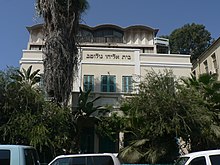Elijahu Golomb
Elijahu Golomb (born March 2, 1893 in Waukawysk , Russian Empire , † June 11, 1945 in Tel Aviv , Palestine ) was a Zionist and Jewish underground fighter. He was the founder and leader of the Hagana , leader of the Histadrut and one of the leaders of the Mossad le Alija Bet , and a co-founder of the Achdut HaAwoda party .
Life
Golomb was born the son of a manufacturer in Waukawysk. He received a traditional upbringing and schooling at a Talmud school . At secondary school, Golomb had contact with Russian revolutionaries and was thus confronted with socialist ideas.
At the age of 16 years, Golomb was in what was then the 1909 Ottoman Empire belonging Palestine sent and visited in Jaffa the Herzlia Gymnasium . His classmates included Moshe Sharet and Dow Hoz . Golomb's parents followed in 1911. Golomb's father owned a factory in Jaffa and a flour mill in Tel Aviv.
In 1913 Elijahu belonged to the first class of the Herzlia-Gymnasium. Together with other fellow students, he founded a pioneer student group dedicated to land development. Associated with this was his entry into kibbutz Degania A on the south bank of Lake Genesareth . An Arab raid in which two comrades were murdered was a decisive experience in Golomb's biography, which led him to believe that land development and agricultural work must be closely linked to the defense of the yishuv .
After his father's death in 1914, Golomb returned to Tel Aviv and took over his parents' flour mill . He married Ada Szertok, with whom he had three children. During World War I , Golomb was forced by the Ottoman army to operate the flour mill on the Sabbath as well. Golomb refused and was then publicly flogged on the orders of the Jaffa governor . This religious and public humiliation generated radical resistance in Golomb against the Turks as well as against Jewish leaders who called for service in the Turkish army. When the British Army advanced into Palestine in 1917 , Golomb became the leader of the volunteers for the Jewish Legion . Its primary goal was to protect the yishuv, so Golomb successfully resisted British plans to deploy the Jewish Legion abroad.
In February 1920, Golomb organized aid for the Jewish defenders of Tel Chai . Through further Arab attacks on Jews in April 1920 in Nebi Musa and Jerusalem , Golomb was strongly motivated to found a defense militia and initiated the founding and formation of the Hagana . He was an avowed opponent of the concept of a small military elite, such as the recently disbanded HaSchomer , but advocated equipping and training large sections of the population for national defense . He was also an advocate of targeted combat and retaliatory actions against Arab attacks, but an opponent of blanket reprisals against the Arab population. Since he was a formative personality for the Hagana, this basic orientation of Golomb also flowed into the self-image of the Hagana. As a result of this, the mostly subliminal rivalry with other Jewish militias with a different character, such as B. Irgun and Lechi took care of the fact that the various militias were either dissolved after the establishment of the state of Israel or were absorbed into the IDF .
Golomb was a member of the Hagana Central Committee from 1920 to 1930 and a member of the command level from 1931 until his death in 1945. From 1922 to 1924 he was active in Europe, buying arms in Berlin, Paris and Vienna, and training Jewish pioneer youth organizations. After his return, he became the leading figure in the Hagana because of his personality, although he did not officially hold a title or rank. Golomb trained many later Hagana and IDF leaders and commanders.
Golombs house in Tel Aviv was actually the lead headquarters of the Hagana and conference of the security institutions of the Yishuv . Many important decisions were made here, such as: B. the concept of tower-and-palisade settlements , the establishment of the "Field Force" ( Pelugot Sadeh ) with the approval of the Mandate Government during the Arab uprisings 1936–1939 for direct combat against Arab fighters, the establishment of the Palmach , or the deployment of Paratroopers as agents in occupied Europe.
Golomb died unexpectedly at the age of 52. He is buried in the Trumpeldor Cemetery in Tel Aviv. The Fenice was named in his honor for the crossing in connection with the La Spezia affair in 1946.
Web links
- Elijahu Golomb in JewishVirtualLibrary.org
- Elijahu Golomb in Boeliem.com
- Elijahu Golomb at JewishAgency.org
- Literature by and about Elijahu Golomb in the WorldCat bibliographic database
| personal data | |
|---|---|
| SURNAME | Golomb, Elijahu |
| ALTERNATIVE NAMES | Golomb, Eliyahu |
| BRIEF DESCRIPTION | Zionist and Jewish underground fighter |
| DATE OF BIRTH | March 2, 1893 |
| PLACE OF BIRTH | Waukawysk , Russian Empire |
| DATE OF DEATH | June 11, 1945 |
| Place of death | Tel Aviv , Palestine |

